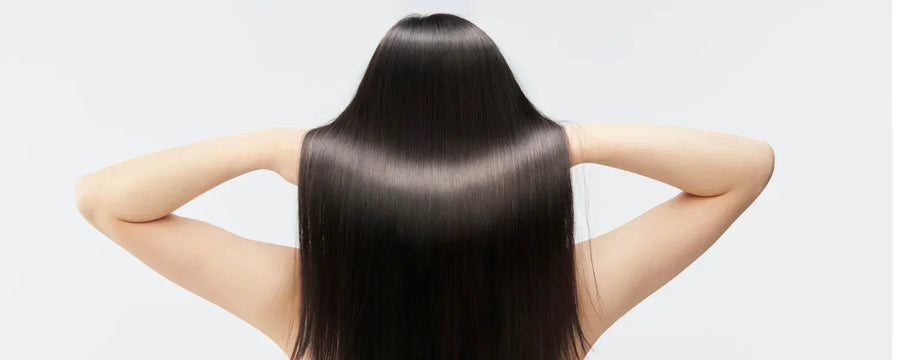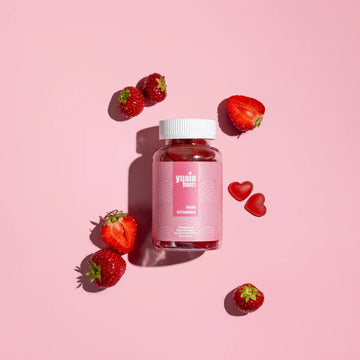

Read through by Dorthe Kristensen
Hairdresser and former co-owner of the award-winning hairdressing chain Zoom by Zoom
With many years of experience in the hairdressing industry, Dorthe has advised many customers about hair and hair care. Dorthe has read through this blog entry to ensure high quality and professionalism. This blog post is professionally updated on April 10, 2025.
Table of contents
Achieving silky, smooth hair is a widely shared aspiration, but it can often feel elusive due to a range of external and internal factors. Environmental stressors, heat styling, improper care routines, and nutritional imbalances can all impact hair texture and shine. In this article, we present a comprehensive guide on how to get silky hair by combining expert tips with scientifically backed methods.
Understanding hair structure and factors affecting silkiness
To understand how to achieve silky hair, it's essential to first understand the basic structure of the hair. Each strand of hair consists of three distinct layers: the medulla at the core, the cortex in the middle, and the cuticle as the outermost layer. Among these, the cuticle plays the most critical role in determining the hair's surface texture and visual shine. The cuticle is composed of overlapping scale-like cells that ideally lie flat and tightly packed, which reflects light and gives hair a smooth, silky appearance. However, when these cells are lifted or disrupted, light is scattered, resulting in a dull, frizzy, or coarse texture.
Numerous internal and external factors influence the state of the cuticle. Environmental conditions such as high humidity or UV exposure can raise the cuticle layer, while mechanical damage from rough towel drying or excessive brushing can lead to breakage. Additionally, frequent use of harsh styling products, regular heat styling without protection, and chemical treatments like bleaching or perming can gradually erode the cuticle’s integrity. This not only impacts the look and feel of the hair but also its resilience and manageability.
Understanding how these elements interact with your specific hair type and condition is crucial. It provides the necessary foundation for selecting the right haircare practices and products, enabling you to proactively prevent damage and promote a silkier, more polished result over time.
Optimal haircare routine for silky hair
Achieving silky, healthy hair requires more than occasional treatments—it depends on a consistent and well-rounded haircare routine. By using the right techniques and products in your daily and weekly regimen, you can enhance moisture retention, reduce damage, and maintain a smooth, glossy finish.
Cleansing the hair
Proper cleansing is key. A sulfate-free shampoo helps maintain natural oils and prevents drying out your hair. Avoid daily washing to retain moisture. On off-days, rinsing with water or using a co-wash can keep your scalp refreshed.
Use lukewarm water to wash your hair—hot water can cause dryness, while cool water at the end helps seal the cuticle for added shine.
Wash frequency should match your hair type. Greasy hair may need more frequent washing, while dry or curly hair can go longer. Over-washing can disrupt scalp balance.
Opt for gentle shampoos with hydrating ingredients like aloe vera or glycerin, and avoid harsh sulfates to protect your hair’s natural barrier.
Conditioning for moisture and manageability
Conditioning is key to maintaining hair’s moisture and texture. A hydrating conditioner should be applied mainly to the mid-lengths and ends, avoiding the scalp to prevent buildup and heaviness.
Leave the conditioner in for three to five minutes to allow proper absorption, and consider wrapping hair in a warm towel to enhance absorption—especially beneficial for thick or color-treated hair. Using a wide-tooth comb while the hair is coated with conditioner can significantly reduce breakage. This method distributes the product evenly, prevents tugging, and makes detangling much easier, especially for longer or curlier hair types.
Rinse thoroughly with cool water, which helps seal the cuticle, enhancing shine and creating a sleek finish. Repeating this step consistently in your routine will help ensure that your hair stays nourished, manageable, and progressively more silky over time.
Deep conditioning treatments
Using deep conditioning treatments once or twice a week can restore hydration and repair damaged hair. These masks are specifically designed to penetrate beyond the surface, reaching the inner layers of the hair shaft where they deliver intensive nourishment. This makes them particularly valuable for individuals with hair that has been exposed to frequent heat styling, coloring, or environmental stress.
Look for ingredients like shea butter, keratin, and plant-based oils such as argan, avocado, or jojoba for optimal effect. These components not only replenish moisture but also help reinforce the hair's natural barrier, reducing the likelihood of future breakage. For those with curly or coarse hair types, deeper conditioning can also improve curl definition and reduce unwanted frizz.
To enhance the effectiveness of these treatments, apply them to towel-dried hair to remove excess water, allowing the product to absorb more efficiently. Use a wide-tooth comb to distribute the mask evenly, ensuring every strand benefits from the treatment.
Leave the hair mask in for the recommended time, typically between 10 to 30 minutes, depending on your hair’s condition and the product's instructions. Some treatments may even be left in overnight for an intensive boost. Over time, this routine can improve elasticity, reduce split ends, restore natural shine, and significantly contribute to the smooth, silky texture that defines healthy hair. Consistent use is key to achieving noticeable and long-lasting results.
What is your go-to method for achieving silky hair?
Natural DIY treatments for silky hair
While commercial hair products and salon treatments can be effective, many people seek gentler, more natural alternatives. Natural DIY treatments can offer noticeable improvements in hair texture, moisture, and shine—often using ingredients readily found at home.
Aloe vera for scalp and hair health
For those who prefer a more natural approach, aloe vera is highly effective due to its enzymatic properties that repair damaged scalp cells and enhance smoothness.
Applying freshly extracted aloe vera gel directly to the scalp and hair can help soothe irritation, reduce dandruff, and promote overall scalp health. Its cooling and anti-inflammatory effects are particularly beneficial for individuals with sensitive scalps or itchy scalps. Aloe vera also contains vitamins A, C, and E, which help maintain normal hair.
To use aloe vera effectively, part your hair and apply the gel directly to the scalp using your fingertips or a small brush. Massage it in gently for a few minutes to stimulate circulation and ensure even coverage.
Leave it on for 20–30 minutes before rinsing with lukewarm water. For an added boost, aloe vera can be mixed with other natural ingredients such as coconut oil. With regular use—at least once or twice a week—aloe vera can help improve overall hair texture, manageability, and hydration levels, making it a reliable component in a natural haircare routine.
Apple cider vinegar rinses for shine and clarity
Apple cider vinegar rinses are a simple yet effective natural treatment to promote shine, reduce buildup, and rebalance the scalp's pH. Its mild acidity helps seal the hair cuticle, enhancing smoothness and light reflection for a glossier appearance. ACV also clears away residue from styling products and hard water, leaving hair lighter and more manageable. To make a rinse, mix one to two tablespoons of raw, unfiltered ACV with one cup of cool water.
After shampooing and conditioning, pour the mixture evenly over your hair, leave it on for a few minutes, then rinse with cool water. The scent fades as hair dries, but essential oils like lavender or rosemary can be added for fragrance. When used weekly, ACV rinses support scalp health, improve texture, and add noticeable shine—making them a valuable step in a natural haircare routine.
Nourishing oil massages
Oil massages, using coconut oil, olive oil, argan oil, and castor oil offer unique benefits—ranging from deep hydration and frizz control to damage repair and thicker hair. Warming the oil slightly before application enhances absorption, allowing nutrients to penetrate the scalp and hair shaft more effectively.
For best results, massage the oil into the scalp using gentle, circular motions for 10–15 minutes, then wrap the hair in a warm towel to retain heat. This not only nourishes and strengthens the hair but also reduces stress, promoting overall scalp health. Using one to two times per week can lead to softer, shinier, and more resilient hair over time.
Lifestyle adjustments for healthy hair
A balanced diet rich in biotin, vitamin E, and omega-3 fatty acids will help maintain normal hair. Staying well-hydrated is equally important, as water helps maintain hair elasticity and prevents dryness or brittleness.
Simple habits like carrying a water bottle or setting hydration reminders can improve both overall health and hair condition. Managing stress is also crucial, as high cortisol levels can disrupt the hair growth cycle and lead to shedding.
Professional treatments and products
Salon treatments like keratin therapy offer long-lasting smoothness and manageability. These treatments work by filling in damaged areas of the hair shaft and sealing the cuticle, leading to visibly shinier and silkier hair.
There are also many high-quality products available that promote silkiness. Nourishing hair masks, serums, and leave-in conditioners formulated with ingredients like argan oil, hyaluronic acid and keratin can dramatically improve texture and shine over time.
Daily practices to maintain silky hair
-
Dry with care: Use a microfiber towel to gently blot, not rub, your hair. Microfiber reduces frizz and breakage by absorbing water without roughening the cuticle. Let hair air dry slightly before wrapping to minimize vulnerability.
-
Apply heat protectant: Before using styling tools, apply a heat protectant spray containing silicones or hydrolyzed proteins. Allow it to dry for a few minutes to ensure full coverage and reduce heat-related damage.
-
Use lower heat settings: Style on medium to low heat and avoid passing over the same section repeatedly to prevent cumulative damage.
-
Opt for heat-free styles: Try braiding damp hair or using foam rollers for styling. These alternatives help maintain softness without exposing hair to high temperatures.
-
Sleep smart: Switch to bamboo pillowcases to reduce friction and moisture loss. Tie your hair loosely or wear a bamboo bonnet to prevent tangles and maintain smoothness overnight.
Embracing a holistic path to silky, healthy hair
Getting silky hair requires a holistic approach, combining the right care routine, natural treatments, healthy habits, and correct use of products. Achieving consistently silky hair is not about a single miracle product, but rather about building a thoughtful, long-term routine tailored to your individual hair type and lifestyle.
From cleansing and conditioning routines to mindful nutritional choices and environmental awareness, every step you take contributes to your hair's resilience and radiance.
By understanding your hair’s structure and responding to its specific needs, you can transform its texture, achieving a smooth, glossy finish that reflects both health and beauty. Patience and consistency are key—doing these practices gradually will not only yield visible results but also promote long-lasting hair health.
With time and care, silky hair becomes more than just a goal; it becomes a natural outcome of nurturing your hair from root to tip.
Get a 10% discount code sent to you
Receive the best tips and tricks for your hair from Lotte and Nanna 🥰
 2-5 day delivery
2-5 day delivery
 25.000+ satisfied customers
25.000+ satisfied customers
 Satisfaction Guarantee
Satisfaction Guarantee









